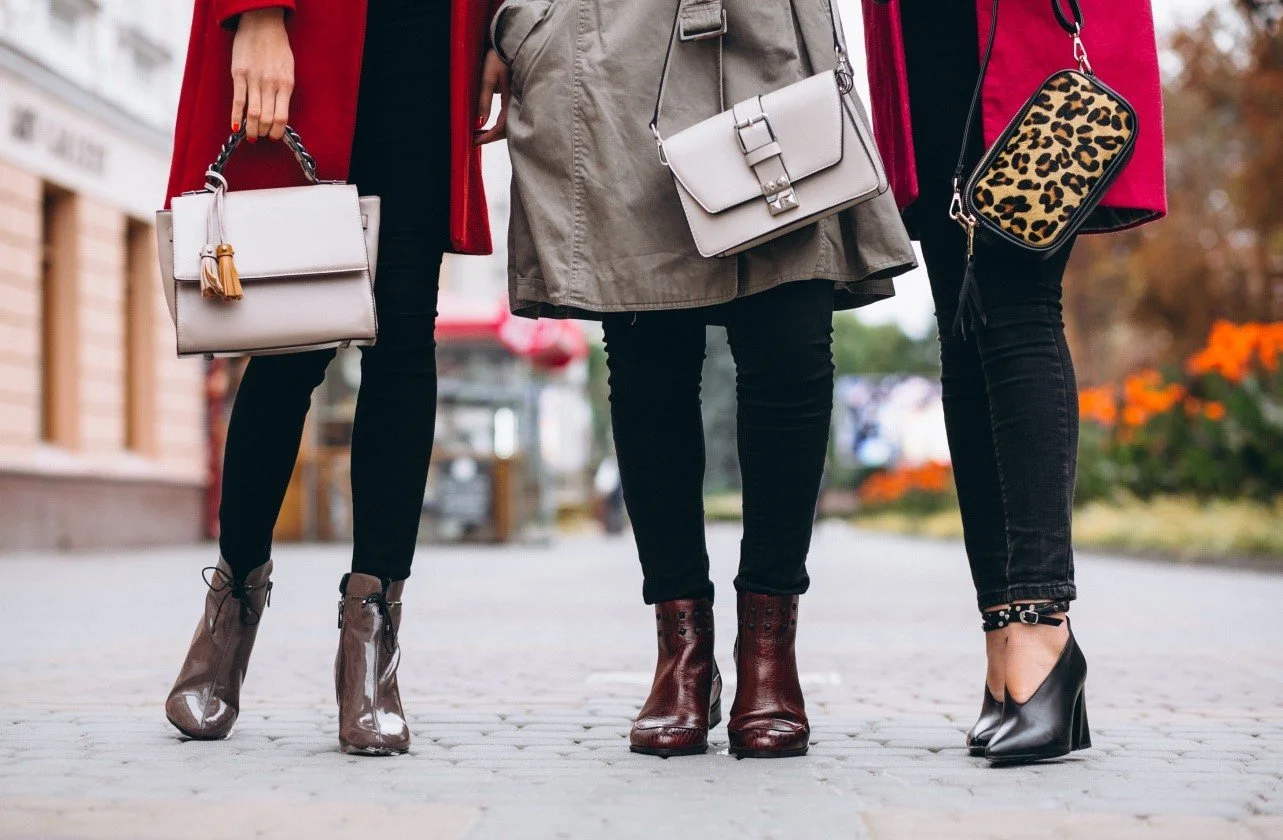Women’s Boots & Pumps Trends to Watch in 2025 A Deep, Research-Backed Guide
Introduction: Why 2025 Feels Different for Footwear?
The past few years have accelerated two big shifts in footwear: comfort and sustainability. Post-pandemic dressing fused with a long-term taste for elevated casual (think: smart-casual with structure), and consumers now insist that shoes be both wearable and responsible. Designers are answering with hybrid soles, quiet metallics, low-sculpt heels, and novel materials, all while keeping an eye on repairability and true lifecycle impact.
Below, we unpack the trends and the evidence behind them so Robert Zur customers (and designers) can shop and design with confidence.
The Silhouette Story: Pumps and Boots that’ll Dominate 2025
Pumps — The New Vocabulary for Elegance
Low-to-Mid Heels Rule. The tilt away from sky-high stilettos toward 1–2.5” heels continues. Heels that flatter but don’t fatigue — kitten heels, block heels, and sculpted low cones, are being specified for office-ready and travel-friendly designs. These shapes read professional while supporting longer workdays.
Square and Almond Toes After years of pointy extremes, square and refined almond toes balance comfort and chic. They leave more room in the toe box, reducing pressure and allowing pumps to be practical commuter shoes, not just dress pieces.
Hybrid Pumps (athleisure meets heels) Expect pumps with hidden cushioning and flexible soles borrowed from sneaker tech, comfort-first pumps that still read dressy.
Quiet Metallics & Satin Finishes Instead of flash, designers are choosing brushed metallic trims and soft satin for evening pumps, a subdued sparkle that elevates without feeling costume-like.
Boots — The Workhorse Silhouettes that Keep Evolving
Ankle Boots: The Carry-Everywhere Refined ankle boots (Chelsea and zip styles) remain the most practical buy. In 2025, we’ll see slimmer shafts, elevated soles (think a modest platform), and more minimalist profiles to match cropped trousers and midi skirts.
Chunky Lug-Soles, But Refined. The chunky-sole moment adapts: lug soles are getting slimmer, cleaner edges, and softer proportions.
Tall & Sculptural Boots Knee-highs return with architectural details (stitched panels, subtle sculpted heels) that make them statement pieces while preserving wearability.
Convertible Styles Fold-down cuffs, detachable panels, and convertible heels (loafer-to-mule styles) let a single pair serve multiple looks — ideal for travel and capsule wardrobes.
Material & Tech Breakthroughs to Watch
1) Leather Alternatives: Piñatex, Mycelium, and the Reality of Scaling
Sustainable “leathers” are one of 2025’s headline stories. Several alternatives show promise — but the devil’s in the details.
Piñatex (pineapple-fiber leather): Ananas Anam’s Piñatex remains a commercially used option for brands seeking a plant-based leather. Consumers like the concept of upcycling agricultural waste into luxury textiles.
Mycelium-based Leathers (Mylo & similar): Mushroom-leather innovations have attracted major attention for their low-land-use and fast growth cycles. Mycelium technology promises a leather-like hand while cutting animal-leather impacts — but it’s still scaling. Recent industry reporting shows commercial deployments exist, yet supply and finish consistency vary, and some firms paused or restructured scaling plans — so buyers should expect innovation but also partial availability as the sector matures.
Practical note: Many alternative leathers require polymer coatings for durability (making biodegradability harder). When choosing “vegan leather” products, ask brands how materials are finished and how they perform in rain, flex, and creasing tests.
2) Insole and Comfort Tech: Why the Market Proves Demand
Comfort technology isn’t niche; it’s a growth engine. The global insoles market is growing rapidly (projected to expand strongly through 2029), driven by demand for advanced foams, gels, and smart insoles, a fact reflecting how consumers expect everyday shoes to be engineered for health and comfort.
Expect pumps and boots with factory-integrated memory foam, gel inserts, antibacterial linings, and even smart insole options that track steps or pressure maps.
3) Hybrid Sole Engineering
Design teams are blending flexible driving-sole feel with EVA cushioning and thin TPU pods for long walks. The goal is a pump that protects the forefoot and a boot that doesn’t feel clumsy, a reconciliation of form and function.
4) Coatings & Finishes that Matter
Water-repellent, non-toxic sprays and coatings let suede and nubuck participate more in city footwear categories.
Metallic finishes in 2025 favor micro-brushed or satinized textures over chrome — better for wear and less likely to show scuffs.
What Sustainability Actually Looks Like for Boots & Pumps in 2025
Longevity > Labels
Real sustainability often starts with long life. Consumers and brands increasingly judge a shoe’s footprint by how long it lasts and whether it can be repaired or resoled.
Traceable tannery practices (closed-loop water systems, better effluent controls) are major differentiators. Buyers should ask if hides are vegetable-tanned, and if tanneries disclose water and chemical treatment processes.
Repair networks: A shoe that can be re-soled, re-healed, and re-lined has a better lifecycle. Small-batch, repairable designs are trending.
New Materials (Brief Recap)
Piñatex and plant-based leathers show promise for uppers; mycelium leathers are exciting but still maturing. Read brands’ transparency statements and durability data before judging them purely on sustainability claims.
The Business Signals: What The Market Is Telling Designers & Retailer
Comfort-first is a sales driver. Market reports show insoles and comfort tech segments growing, consumers pay for comfort features now.
Sustainability matters, but so does proof. Customers want transparency (materials, tanning processes, end-of-life plans). Brands that communicate traceability will win trust.
Omnichannel experience. Shoppers prefer to try boots in store but research pumps online. Accurate digital fit tools, inclusive sizing, and easy returns are decisive.
Resale & circularity. Luxury resale platforms list quality boots and pumps for strong resale value. Products designed for repair/resolution show better lifetime economics.
Styling Trends & Outfit Choreography For 2025
Pumps' Styling Beats for 2025
Workwear rules: Low block heels + cropped trousers + longline blazers. Soft neutrals or deep navy replace stark black for a modern corporate palette.
Day-to-Evening ease: Sculpted low-heel pumps in a satin or soft metallic finish worn with a midi slip dress for seamless transition.
Color pops: Single bold color pumps (e.g., forest green or marigold) against neutral suits are embraced as “the accent piece.”
Boots' Styling Beats For 2025
Chelsea minimalism: High-quality leather Chelsea boots (sleek black, chestnut) paired with pleated midi skirts and trench coats.
Utility luxe: Lug-soled boots with narrow silhouettes and refined materials — think “combat boot, but tapered and chic.”
Tall boots + knitwear: Knee-high boots with midi ribbed sweater dresses remain a dominant fall/winter combo.
Accessorizing & Finishing
Coordinate bag leather with shoe leather for modern cohesion.
Mix metals: gold hardware on boots + brushed metallic pumps can both exist on a single outfit if balanced.
Size, Fit & Comfort Guidance (Practical Shopping Tactics)
Fit Notes For Pumps
Try pumps later in the day when feet swell.
Go for a slightly snug fit at purchase; most leathers relax ~¼–½ size.
For narrow feet, pointed toes with adjustable straps help lock the foot without compressing.
Fit Notes For Boots
For knee-highs: measure calf circumference — many brands offer narrow/wide shaft options.
For lug-soled boots: thicker socks require ordering that half size up.
Orthotics & Aftermarket Solutions
Many quality boots and pumps accept full-length or ¾-length insoles. If you rely on orthotics, buy shoes with removable footbeds and roomy toe boxes.
Care & Repair: Making Shoes Last
Daily Habits
Rotate your shoes — give each pair 48 hours to air out. Use cedar shoe trees to wick moisture and preserve shape.
Weekly/Monthly Care
Wipe leather clean with a damp cloth and apply conditioner monthly.
Brush and apply suede protector to nubuck regularly, and store it in breathable bags.
Seasonal Deep-Care
Before winter: apply waterproofing wax to leather boots and store pumps in a cool, dry place.
After wet weather: wipe off salt, let dry naturally, and condition within 48 hours.
Repair & Resoling
Choose a cobbler with experience re-gluing, stitching, and resoling. Resoling stitched construction (Blake, Goodyear) is often cost-effective and sustainable.
Pricing Signals & Value: How To Think About Cost-Per-Wear
Buying cheap, replacing often usually costs more over time. High-quality, repairable boots and pumps typically have better cost-per-wear.
Mid-to-high market: Spend more on the pair you’ll wear weekly (neutral pump, ankle boot). Save on occasional statement pieces.
Regional & Climate Considerations (Practical Tips)
Coastal & Humid Regions
Favor coated leathers and quick-dry insoles; rinse salt spray off boots after exposure.
Cold & Snowy Regions
Waterproofing and insulated linings help; dedicate a pair for snow to avoid salt damage on dress shoes.
Warm Climates
Perforated leather pumps and low-shaft ankle boots improve breathability.
Retailer & Designer Checklist: Building a 2025-Ready Collection
For designers/retailers planning collections, prioritize:
Core neutral pumps with comfort tech (memory foam, flexible sole).
Versatile ankle boot in full-grain leather, mid platform, narrow profile.
One statement pump in an on-trend color/finish (satin or soft metallic).
One weatherproof lug or riding boot with refined proportions.
Repair & resole-friendly construction for key styles.
Material transparency and clear care instructions.
Social & Cultural Cues: Influences, Runway, And Street Signals
Runway continues to influence silhouette direction — expect more sculptural, wearable heels and elevated boots (think refined lug, not industrial).
Influencers & micro-trends: Short-form video content (TikTok, Reels) is showing “one pair, five looks” capsule styling — consumers love versatility and shareability.
Celebrity styling continues to nudge mainstream taste toward tall boots and comfortable low heels.
What Shoppers Should Ask Brands (a Short Checklist)
What is the upper made of? Where was it sourced/tanned?
Are coatings and adhesives disclosed and safe?
Can the shoe be resoled or repaired locally?
What comfort tech is included (removable insoles, memory foam, arch support)?
Future Signals: What to Watch Beyond 2025
Scale of lab-grown alternatives: watch for consistent finished-goods supply and durability testing for mycelium leathers.
Smart insoles & biomechanics: expect more integration of sensors and app-enabled insole tracking for pressure and gait feedback.
Circular business models: more brands will test rental, repair, subscription, and resoling-for-discount offers.
Practical Shopping Guide: How To Pick the Right Pair Right Now
Start with function — commuting, travel, or events? Let that guide heel and sole choices.
Choose neutral first — invest in a neutral pump or ankle boot you can wear weekly.
Check return policy — fit is personal; easy returns reduce risk.
Plan for repair — prefer models with stitched construction if you want them repaired and resoled.
Styling Recipe: 25 Outfit Prompts Using Pumps & Boots
Navy blazer + cropped trousers + nude pump
Cashmere sweater dress + knee-high boots
Slip dress + metallic pumps + denim jacket
Leather skirt + lug-sole boots + oversized blazer
Summary & Actionable Takeaways
Comfort sells: integrate memory-foam and supportive designs into core styles.
Sustainability is nuanced: Piñatex and mycelium look great, but check finish/coating and durability claims before labeling anything “green.”
Repairability = sustainability + value: choose resolable construction for long-term customers.
Styling = versatility: consumers want pieces that travel, work, and play; design and market with multipurpose wear in mind.
Final Thoughts, the Right Pair is Both a Tool and an Expression
Boots and pumps will keep evolving, but the fundamentals remain: fit, materials, and durability. In 2025, the most successful products will marry comfortable engineering with thoughtful materials and clear reparability. For shoppers, the best buys are those you actually wear — often.
Want expertly crafted pumps and boots that balance comfort, style, and responsible design? Explore Robert Zur’s Women’s Collection at RobertZur.com — we design to be worn, loved, and repaired.


